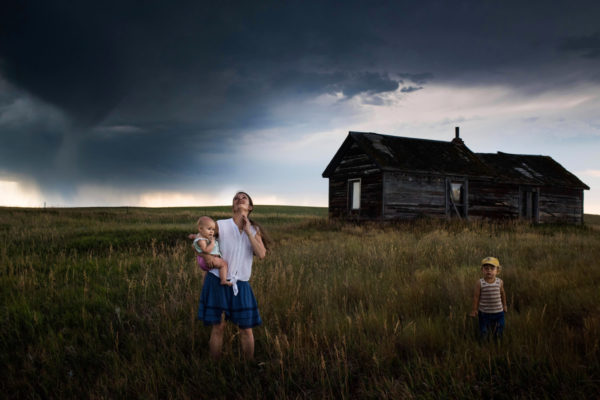By Conor Risch

Eliza Blue holds her daughter Emmy as her son Wesley closes his eyes and feels the coming storm winds on his face as they stand near an abandoned farmhouse on their leased land in Bison, SD. Ranchers and farmers have spent much of the droughty summer watching clouds on the horizon, hoping storms would hit, but most pass by without rain.
This image from Mark Kauzlarich’s project “The McFarthest Place” is particularly poignant as we consider recent reports about the impacts of climate change. It’s a portrait that alludes to the challenges of sustaining a family in a deeply rural environment, but there are some contradictory elements that make the image particularly engaging. At first glance the abandoned farmhouse and dark clouds give the image an ominous feeling, but then we look at the hopeful expression on the face of the mother, Eliza Blue, and we realize the real threat isn’t from the storm—it’s that the storm might pass without quenching a drought-stricken landscape.
People who rely directly on the land for their livelihood may very well look at this image and immediately recognize the storm as a hopeful symbol. The difference in how viewers understand the dark, looming clouds gets at the heart of Kauzlarich’s project, which looks at the social and economic challenges created by population loss in America’s most isolated, rural places. Kauzlarich’s project tells intimate stories of people in communities that are hundreds of miles from a McDonald’s restaurant. It’s a clever and immediately recognizable measure of isolation, and the iconic fast food chain symbolizes easy access goods, services, specialized medical care and other resources urban and suburban populations take for granted.
In Bison, SD, where Eliza Blue lives with her family, a storm that would drive city dwellers indoors, takes on a different meaning. It’s lifeblood. What’s truly ominous a changing climate that will cause an increase in drought, and more clouds that, as Kauzlarich tells us in his caption, “pass by without rain.”
Conor Risch is a Seattle-based writer and senior editor of Photo District News (PDN). Follow him on Twitter @c_risch.